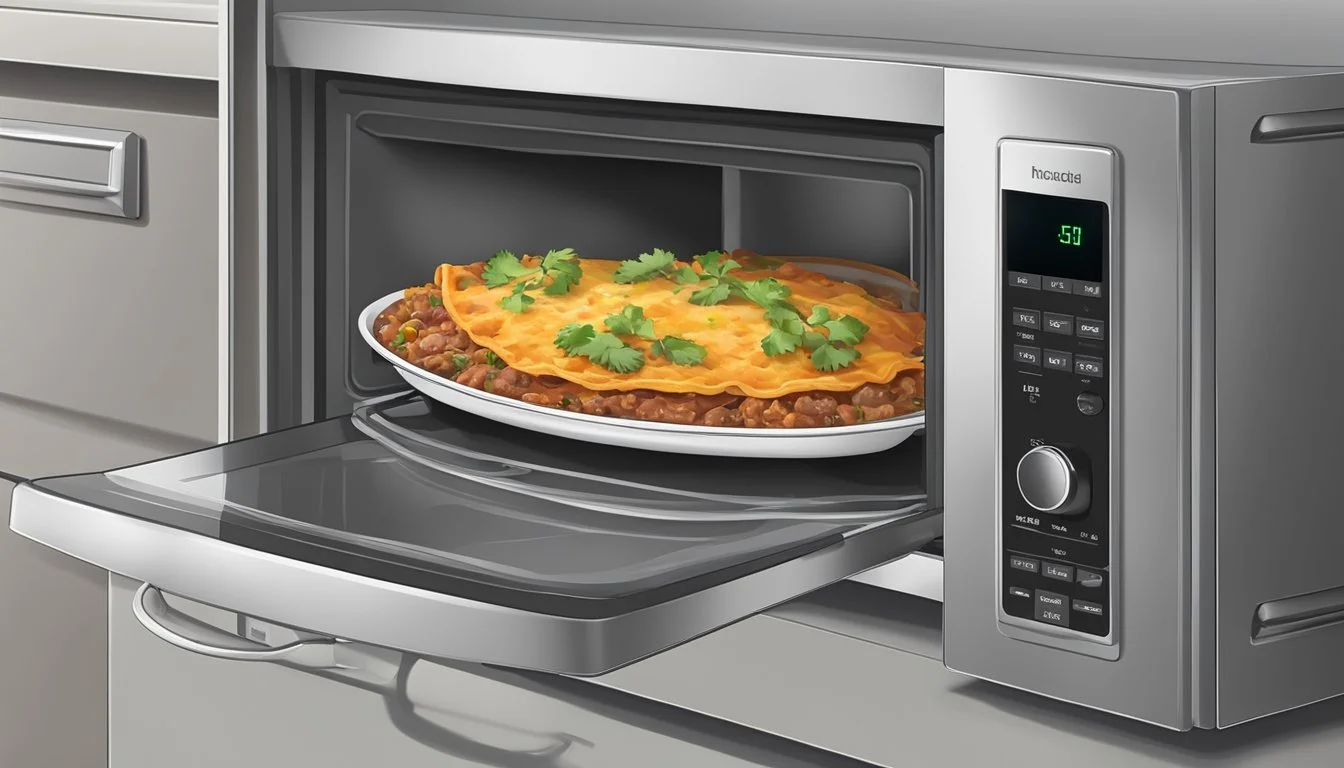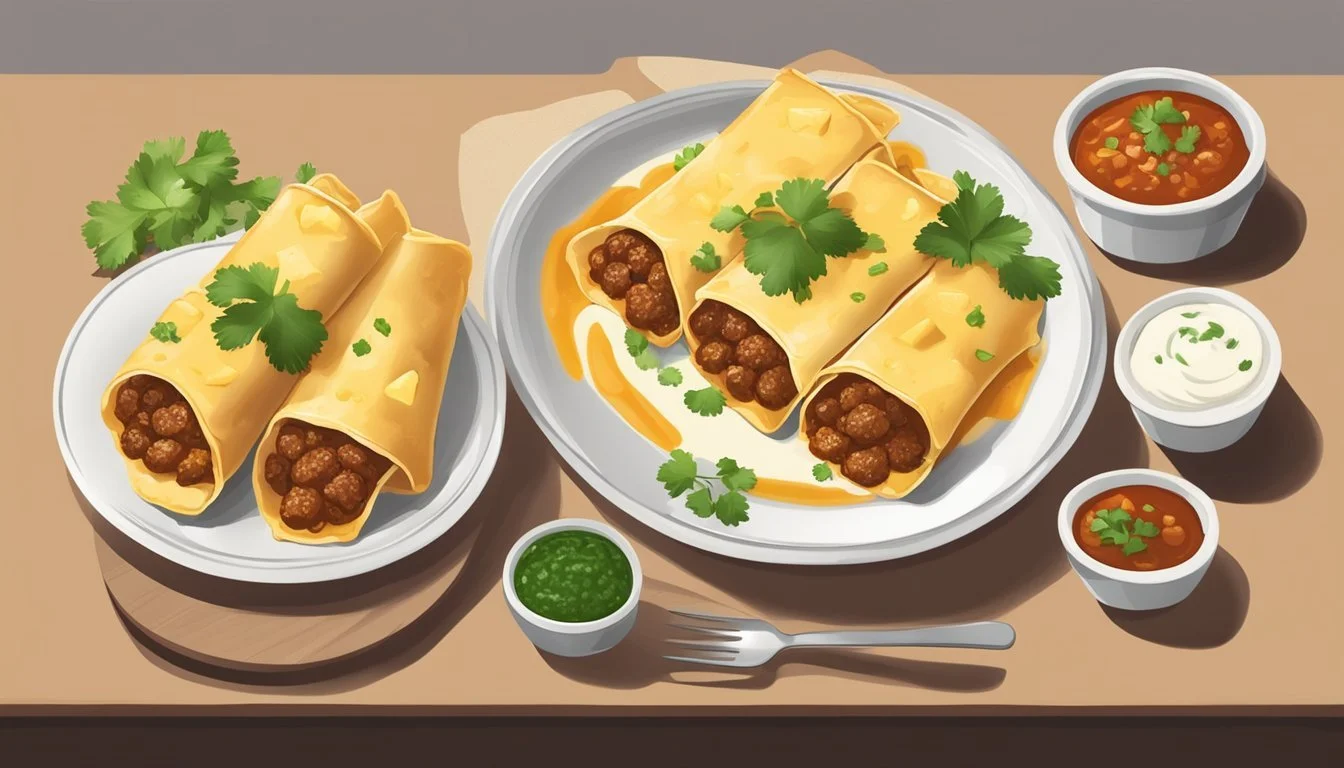How to Reheat Beef Enchiladas
Best Methods and Tips
Reheating beef enchiladas doesn't have to be a challenge. Whether you've got leftovers from a hearty dinner or a prepared dish waiting in the freezer, making sure your enchiladas are just as delicious the second time around is essential. The key to perfectly reheating beef enchiladas is ensuring they retain their flavor and texture without becoming soggy or dry.
There are several methods to reheat enchiladas, each offering a unique advantage. Using an oven is a popular choice as it helps maintain the dish's integrity. Simply preheat the oven to 350°F, place the enchiladas in an oven-safe baking dish, and cover with aluminum foil. Bake for about 20 minutes, then uncover for the last 5-10 minutes to allow the cheese to melt and get slightly crispy.
On the other hand, a skillet or frying pan can be a quicker method, adding a delightful crisp to the bottom. Heating a small amount of oil on medium-high heat and cooking the enchiladas for 2-4 minutes will achieve this effect. For those in a hurry, the microwave is a viable option. Place the enchiladas on a microwave-safe plate, cover with a splatter guard, and heat on high for a couple of minutes, checking regularly.
Understanding Enchiladas
Enchiladas are a beloved Mexican dish featuring tortillas rolled around a filling and covered with sauce. Key factors include ingredients, texture, and storage methods.
Ingredients and Structure
Enchiladas typically consist of tortillas, filling, enchilada sauce, and cheese. Common fillings include meat such as ground beef or chicken, as well as beans, vegetables, or a combination.
Tortillas can be corn or flour, each offering distinct flavor and texture. Cheese is often sprinkled inside and on top, melting into a gooey layer. Enchilada sauce—red, green, or mole—coats the assembled dish, providing moisture and flavor.
Cheese enchiladas might use a variety of cheeses, such as cheddar or Monterey Jack, while ground beef enchiladas focus on seasoned beef paired with cheese and sauce.
Texture Considerations
The texture of enchiladas is central to their appeal. The tortillas should soften yet hold their shape. Overly hard or soggy tortillas can ruin the dish. The sauce plays a big role in achieving the right consistency.
Too little sauce can result in dry enchiladas, whereas too much can make them soggy.
A perfectly reheated homemade enchilada balances the tender tortillas with the creaminess of melted cheese and the richness of the filling, whether it's beef, chicken, or beans.
Storing Leftover Enchiladas
Proper storage of leftover enchiladas is crucial for maintaining their quality. They should be placed in an airtight container to retain moisture and flavor.
Freezing is an option, allowing enchiladas to be kept for longer periods. To freeze, place them in a single layer on a baking sheet to freeze individually, then transfer to a freezer-safe bag or container.
For refrigerated storage, consume within 3-5 days to prevent spoilage. Always reheat thoroughly to ensure they reach a safe temperature, enhancing the dish's flavors and textures while preserving its original appeal.
General Reheating Guidelines
Reheating beef enchiladas requires careful attention to safety, moisture retention, and precise timing and temperature to ensure the best results. Following these steps can help maintain the quality and safety of your enchiladas.
Safety and Preservation
Ensuring food safety is critical when reheating beef enchiladas. Beef enchiladas should be stored in an airtight container within two hours of cooking to minimize bacteria growth. Always check that the enchiladas are reheated to an internal temperature of at least 165°F (74°C). This temperature ensures that any potentially harmful bacteria are destroyed. Avoid using plastic wrap in the reheating process as it can release harmful chemicals when heated. Instead, cover the dish with a microwave-safe cover or aluminum foil.
Moisture Retention
To prevent soggy enchiladas, it’s crucial to manage moisture effectively during reheating. Using a damp paper towel or covering with a splatter guard in the microwave helps retain moisture without making the tortillas soggy. In the oven, covering the dish with aluminum foil can help retain moisture and heat evenly. Reheating in a skillet with a small amount of oil can also help maintain the texture, making the bottom crispy while keeping the interior moist.
Timing and Temperature
Precise timing and temperature are essential for reheating beef enchiladas. For oven reheating, preheat the oven to 350°F (175°C) and bake the enchiladas for 20-25 minutes. If reheating in the microwave, place the enchiladas on a microwave-safe plate and heat on high for 2-3 minutes, checking and turning halfway through. When using a skillet, heat a small amount of oil over medium-high heat and cook the enchiladas for 3-4 minutes per side. Always measure the internal temperature to reach at least 165°F (74°C) to ensure safety.
Reheating Enchiladas in the Oven
Reheating enchiladas in the oven ensures they are heated evenly and retain their texture. This method works well for refrigerated or frozen enchiladas.
Oven Method Overview
Using a conventional oven is one of the most efficient ways to reheat beef enchiladas. It allows for even heating and prevents sogginess. Preheat the oven to 350°F (175°C) to prepare for reheating. A baking tray or a casserole dish is ideal for this method. Aluminum foil can be used to cover the enchiladas to retain moisture.
To maintain texture, avoid reheating at temperatures higher than 350°F. This can dry out the enchiladas. A middle rack position is optimal for an even distribution of heat.
Step-by-Step Oven Reheating
Preheat the oven to 350°F (175°C). While the oven is heating, place the beef enchiladas in a baking tray or casserole dish. Cover with aluminum foil to keep them moist during reheating.
Insert the dish into the oven. For refrigerated enchiladas, bake for about 20-25 minutes. For frozen enchiladas, extend the time to 30-35 minutes. Check periodically to ensure they are heated thoroughly.
For additional crispness, remove the foil during the last 5 minutes of heating. This allows the edges to crisp up, adding texture.
Avoiding Common Oven Mistakes
Avoid common pitfalls such as overheating, which can dry out the enchiladas. Do not set the oven temperature above 350°F. This temperature offers the best combination of even heating and moisture retention.
Ensure the enchiladas are covered with aluminum foil initially. This prevents them from drying out. Placing them on the middle rack helps distribute heat evenly.
Do not overcrowd the baking tray or casserole dish. This ensures each enchilada is heated uniformly. Check frequently to avoid overcooking. Using a baking tray lined with parchment paper can make cleanup easier.
Proper reheating ensures the enchiladas remain delicious and satisfying.
Alternative Reheating Methods
To reheat beef enchiladas effectively, various kitchen appliances can be used to achieve the ideal balance of taste and texture. Key points include utilizing specific methods for efficient and satisfactory reheating results.
Using a Toaster Oven
A toaster oven is a convenient alternative to a conventional oven. Preheat the toaster oven to 350°F. Place the enchiladas on an oven-safe dish. Covering them with foil can help retain moisture and prevent drying out.
Heat them for 15-20 minutes if they are refrigerated. For frozen enchiladas, extend the time to about 25-30 minutes. Check that the internal temperature reaches at least 165°F to ensure they are adequately reheated.
Microwave Reheating
Microwave reheating is fast and efficient. Place the enchiladas on a microwave-safe plate. Cover them with a damp paper towel to prevent them from drying out. Heat on medium power for about 2-3 minutes.
If the enchiladas are frozen, consider using the defrost setting first, then heat in intervals of 1-2 minutes until fully warmed. It’s crucial to ensure that the enchiladas are heated evenly, so rotate the plate halfway through the reheating process.
Skillet Heating Technique
Using a skillet can provide a crispy texture. Preheat the skillet over medium heat and add a small amount of oil. Place the enchiladas cheese side up. Cover the skillet with a lid or aluminum foil to trap the steam, which will aid in reheating.
Cook for 5-7 minutes, checking occasionally to avoid burning. This technique works well for enchiladas that were stored in the refrigerator. The skillet method ensures that the tortillas become crispy while the filling remains heated thoroughly.
Utilizing an Air Fryer
An air fryer can offer a quick and crispy reheating method. Preheat the air fryer to 350°F. Place the enchiladas in the air fryer basket, ensuring they are not stacked to allow hot air to circulate properly.
Reheat for 6-8 minutes for refrigerated enchiladas. For frozen ones, expect to cook for about 10-12 minutes. The air fryer’s rapid circulation of hot air helps achieve a crispy exterior while ensuring the filling is warm.
Serving and Garnishing
When serving beef enchiladas, presentation and the selection of complementary accompaniments enhance the overall dining experience. This section covers effective plating techniques and the best sides to pair with your enchiladas for an appetizing meal.
Proper Plating and Presentation
To plate beef enchiladas, begin by placing the enchiladas neatly on a plate. Drizzle extra sauce over the top to keep them moist and add a burst of flavor. Ensure that the sauce spreads evenly without drowning the enchiladas.
Garnish with a dollop of sour cream in the middle. This not only adds a creamy texture but also balances the richness of the beef. Fresh cilantro sprinkled on top enhances the presentation with a pop of green. Integrating contrasting colors and textures makes the dish visually appealing and appetizing.
Recommended Accompaniments
Beef enchiladas pair wonderfully with Mexican food staples. Serve them with a side of fluffy rice to soak up the extra sauce. Refried beans add a hearty element and make the meal more satisfying.
Offering a small bowl of fresh salsa provides a tangy contrast to the rich beef filling. Consider adding guacamole for a creamy and rich accompaniment that complements the other side dishes. These accompaniments help to create a balanced and complete meal, enriching both flavor and texture.
Additional Tips and Tricks
Reheating beef enchiladas involves several techniques to ensure they remain flavorful, avoid sogginess, and adapt based on their frozen or fresh state.
Enhancing Flavor After Reheating
To elevate the flavor of reheated enchiladas, consider adding fresh toppings like chopped cilantro, diced onions, or sliced avocado. Incorporate freshly grated cheese for a richer taste.
Sprinkling a bit of lime juice over the top before serving can enhance the beef's savory notes. Additionally, a side of salsa or a spoonful of sour cream adds a refreshing contrast to the enchiladas.
Preventing Soggy Tortillas
One common challenge is keeping the tortillas from getting soggy. Ensure the tortillas don't sit in excess sauce during reheating. When using the oven, consider placing them on a wire rack to keep the enchiladas elevated above the sauce.
Wrapping the enchiladas in aluminum foil helps maintain texture. Using a damp paper towel for microwave reheating can prevent tortillas from drying out while ensuring they maintain their structure.
Differences in Reheating Frozen vs. Fresh Enchiladas
When reheating frozen enchiladas, it’s essential to thaw them completely in the refrigerator for best results. Once thawed, follow the oven reheating method, setting the oven to 350°F and using a baking tray lined with foil.
For fresh enchiladas, they usually require less time in the oven, and the filling heats more evenly. Covering the dish with foil prevents the surface from drying out while keeping the enchiladas warm and moist.
Using oil and split cooking methods can improve results for both frozen and fresh varieties. For instance, start with a low initial heat and increase towards the end to get a perfect balance between a soft inside and a crispy surface.






